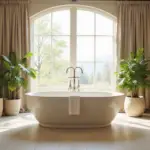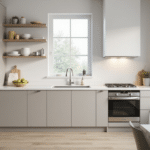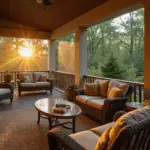Your yard isn’t just an extension of your home—it’s a canvas for creating balance between nature and modern living. As we increasingly seek refuge from our digital lives, thoughtfully designed outdoor spaces offer the perfect counterpoint to screen time and indoor confinement.
Whether you have a sprawling landscape or a compact urban plot, these 19 yard ideas will help you create a space that feels both serene and functional. Drawing from traditional Japanese principles and contemporary design sensibilities, I’ll show you how to transform your outdoor area into a mindful retreat that works with your lifestyle, not against it.
1. Design a Charming Patio or Deck Retreat
The foundation of any mindful outdoor space begins with a well-designed patio or deck—a place where you can truly disconnect and be present. When designing this area, focus on creating a sense of intention through careful furniture placement and negative space. Unlike cluttered indoor rooms, a zen-inspired patio embraces openness with just a few quality pieces that invite both conversation and contemplation.

For smaller spaces, embrace verticality through wall-mounted planters or tall bamboo screens that draw the eye upward. Choose multi-functional furniture with clean lines—a storage bench that doubles as seating or a simple low table that works for both dining and relaxation. Remember that in zen design, each element should serve a purpose, whether functional or contemplative.
The inspiration for this collection struck when I visited a Tokyo apartment with a tiny balcony transformed into a meditation space using just three elements: a single chair, a potted maple, and a small water bowl that reflected the sky.
2. Install a Cozy Fire Pit Gathering Spot
Fire has been a centering element in human gathering spaces for thousands of years, making it perfect for a mindful yard. When selecting a fire pit, consider how it will integrate with your existing landscape. The most balanced designs often appear as though they’ve always been there—sunken pits with stone surrounds feel more grounded than portable metal options that sit atop the space.

Traditional Japanese gardens often incorporate fire elements not as centerpieces but as balanced components within the larger design. Consider arranging seating in a way that doesn’t make the fire pit the sole focus but rather creates a harmonious composition with surrounding plants and pathways. Natural materials like stone, wood, and gravel create cohesion and help the fire feature blend with the environment rather than dominate it.
After months of sourcing and curation, I discovered that the most successful fire pit areas incorporate not just the element of fire but also reference water and earth through nearby plantings or stone elements, creating a complete sensory experience.
3. Build Your Dream Outdoor Kitchen Zone
An outdoor kitchen represents the perfect marriage of functionality and mindfulness—bringing the meditative aspects of cooking into the open air. When planning this space, resist the urge to replicate your indoor kitchen. Instead, embrace the unique qualities of outdoor cooking with simplified, intentional design that focuses on the essentials that bring you joy.
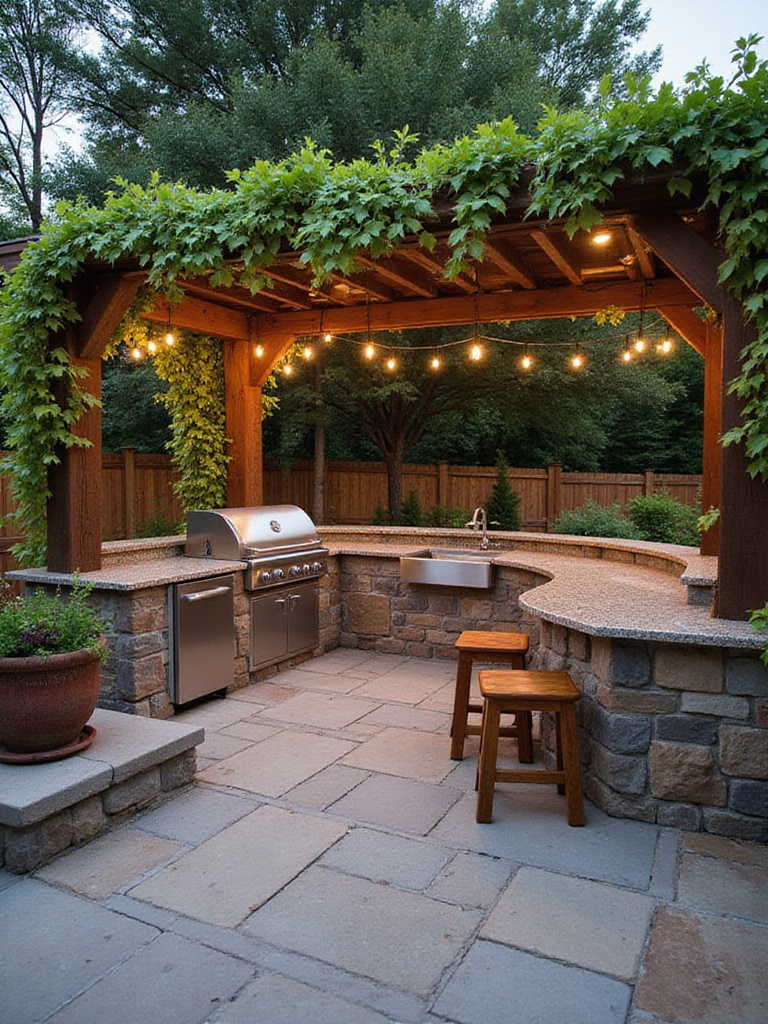
The most successful outdoor kitchens I’ve designed maintain a sense of openness while providing just enough structure. Consider a single counter of natural stone with a built-in grill and simple storage beneath. Add a preparation area with a small sink if possible. The goal is to create a space that supports the cooking process without overwhelming the natural environment or requiring excessive maintenance that detracts from your enjoyment.
The craftsmanship in this collection tells a story of balance between technology and tradition—incorporating modern conveniences while honoring the simplicity of cooking with fire in the open air, just as our ancestors have done for generations.
4. Add Serenity with a Water Feature
Water brings an unmatched quality of reflection and tranquility to yard ideas, creating both visual interest and soothing sounds that mask urban noise. In Japanese design philosophy, water represents flow and impermanence—concepts that help ground us in the present moment. Even small water features can transform the feeling of a space, making it feel cooler and more contemplative.

When selecting a water feature, consider scale carefully. A massive fountain might overwhelm a modest yard, while a simple ceramic basin with a small bamboo spout might be perfect. The sound should be gentle enough to create ambiance without dominating conversation. Position water features where they can capture and reflect light at different times of day, creating a constantly changing focal point that rewards mindful observation.
Look closely and you’ll notice the subtle texture of the water’s surface changes throughout the day, offering different experiences from morning meditation to evening relaxation—this temporal quality is what makes water features so compelling in mindful yard design.
5. Create Easy-Access Raised Garden Beds
Raised garden beds bring growing spaces to a more accessible height, creating opportunities for mindful interaction with plants without the strain of bending. When designing raised beds, consider their placement in relation to your daily patterns—beds placed along pathways you already use will be tended more regularly than those hidden in back corners.

The most successful raised beds combine functionality with aesthetic appeal. Consider materials that complement your home’s architecture—weathered cedar for traditional homes, corten steel for modern spaces. Keep the design simple and geometric, allowing the plants to provide the organic shapes and visual interest. Heights between 18-24 inches work well for seated gardening, while 30-36 inches are ideal for standing cultivation.
What makes this design special is the way it bridges traditional Japanese gardening principles with modern accessibility needs, creating growing spaces that invite daily interaction regardless of physical limitations.
6. Go Native for a Low-Maintenance Landscape
Native plants have evolved over thousands of years to thrive in your specific climate and soil conditions, making them the ultimate low-maintenance yard idea. Beyond requiring less water and care, native plantings create a sense of place and connection to your local environment—a core principle in mindful landscape design.

When transitioning to natives, start by observing what grows naturally in undisturbed areas near your home. These plants will have the best chance of success in your yard. Arrange them in naturalistic groupings rather than formal rows, allowing their natural growth habits to create an authentic landscape. Incorporate rocks and fallen wood to provide structure and habitat, creating a complete ecosystem rather than just a collection of plants.
The environmental story behind this piece began when I realized that my most successful garden designs were those that worked with the local ecology rather than fighting against it—creating spaces that feel both designed and effortlessly natural.
7. Attract Pollinators with a Buzzing Garden
A pollinator garden bridges the gap between beauty and functionality, creating visual interest while supporting crucial ecosystem services. In mindful yard design, we recognize the interconnectedness of all living things—the bees, butterflies, and birds that visit your garden are not just visitors but essential participants in the landscape.

Design your pollinator garden with intentional diversity, including plants that bloom in different seasons to provide year-round support for wildlife. Consider layers of vegetation: ground covers, mid-height perennials, and taller shrubs or small trees. This vertical structure mimics natural habitats and provides different niches for various creatures. Include a simple water source like a shallow dish with pebbles where insects can safely drink.
“The most mindful gardens recognize that we share our spaces with countless other beings. When we design for them as well as ourselves, we create richer, more vibrant environments.” – Kai Nakamura
The unexpected pairing that always works is combining flowering natives with traditional Japanese garden elements like stone lanterns or simple bamboo features—creating spaces that honor both local ecology and design heritage.
8. Lay Down a Beautiful Walkway or Path
Pathways are more than functional elements—they’re opportunities to slow down and experience your garden mindfully. In Japanese garden design, paths are never straight lines but gentle curves that reveal different views as you move through the space. This principle can transform even the smallest yard into a journey rather than just a space to be viewed.

When selecting materials, consider how they’ll feel underfoot and the sound they’ll make when walked upon. Soft materials like fine gravel create a satisfying crunch that announces your presence and keeps you present in the moment. Stepping stones set in groundcover require attention to each step, naturally slowing your pace. Avoid slippery materials that cause anxiety about falling—mindful gardens should promote relaxation, not stress.
The magic of this piece lies in its ability to guide movement without demanding it, creating opportunities for both purposeful journeys and wandering exploration through your outdoor space.
9. Illuminate Your Yard with Strategic Lighting
Lighting transforms a yard from a daytime-only space to a 24-hour retreat, but mindful illumination goes beyond simply banishing darkness. In zen-inspired yard ideas, lighting should be subtle and purposeful—highlighting focal points, ensuring safety along paths, and creating atmosphere without light pollution or harsh glare.

The most successful landscape lighting mimics natural moonlight—soft, diffused, and casting gentle shadows. Consider low-voltage LED systems that consume minimal energy and can be adjusted seasonally. Place lights at ground level facing upward to highlight trees or architectural features, creating dramatic shadows. Use warm light (2700-3000K) that feels natural and relaxing rather than the harsh blue-white of higher temperature bulbs.
The silhouette draws inspiration from traditional Japanese paper lanterns, which provide gentle illumination that respects the night and creates mystery rather than eliminating all shadows—an important concept in creating yards that change and reveal themselves differently throughout the day and night.
10. Enhance Privacy with Screens or Fencing
Privacy elements create the boundaries that define your outdoor sanctuary, but they needn’t be solid barriers that disconnect you from the surrounding world. In mindful yard design, screens and fences should filter rather than block—providing security and seclusion while still allowing connection to light, breeze, and the natural world beyond.
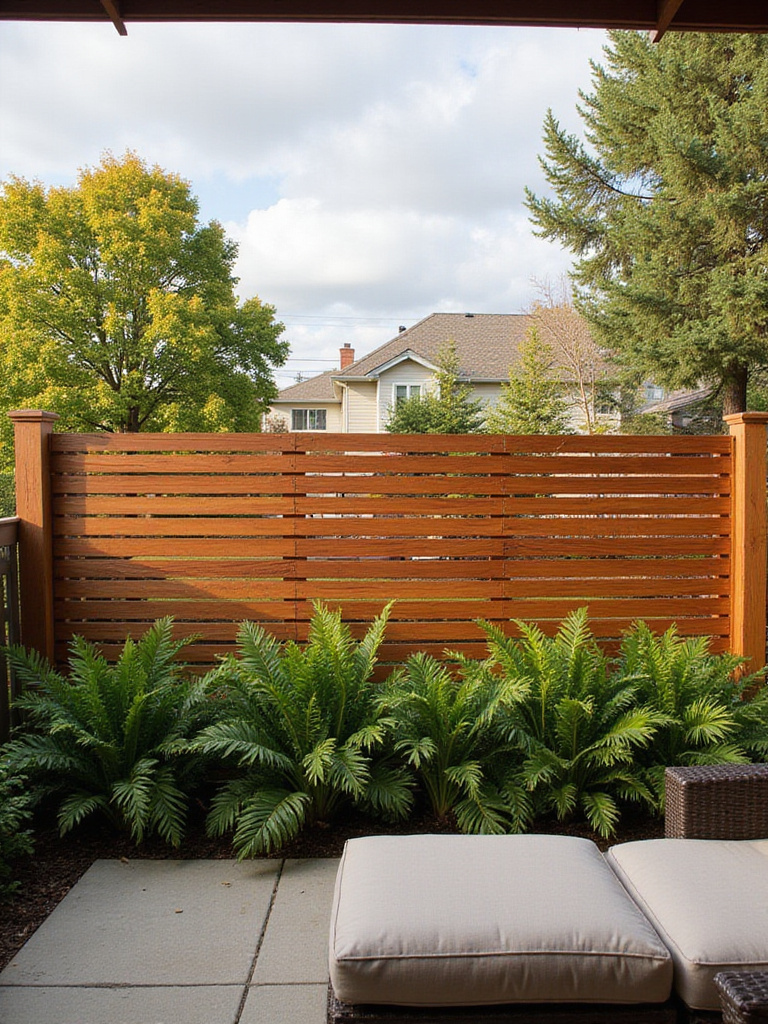
Consider materials that offer textural interest and filtered views: bamboo screens, slatted wood panels, or metal grids that support climbing plants. These semi-transparent boundaries create a sense of enclosure while avoiding the claustrophobic feeling of solid walls. Position screens strategically to block specific sightlines rather than surrounding your entire yard, preserving openness where privacy isn’t needed.
The artisans behind these designs began with the concept of “ma”—the Japanese principle of negative space—creating boundaries that define areas without completely separating them, allowing energy and light to flow naturally through the landscape.
11. Design a Fun and Safe Kids’ Play Area
Children experience the world through their senses, making the yard a perfect classroom for mindful development. Rather than plastic play structures that dominate the landscape, consider natural play elements that blend with your overall design: logs for balancing, smooth boulders for climbing, sand areas for digging, and simple water features for splashing.

The most successful children’s spaces avoid overstimulation, instead providing open-ended elements that encourage imagination and discovery. Leave room for unstructured play and include quiet nooks where children can retreat when overwhelmed. Plant sensory gardens with touchable textures, scented herbs, and edible berries that engage all the senses and teach children to observe closely and move mindfully through the natural world.
Many homeowners wonder how to balance adult aesthetics with children’s needs, but the solution lies in integrated design rather than segregated spaces—creating yards where play elements double as sculptural features and everyone feels welcome.
12. Set Up a Relaxing Hammock or Swing Nook
Few yard ideas promote mindfulness as effectively as a dedicated space for stillness. A hammock or swing creates a literal pause point in the landscape—a place to stop, breathe, and simply be present. The gentle motion of swinging or swaying has been shown to reduce stress hormones and promote mental clarity, making these features particularly valuable in our hyper-stimulated world.

When creating a hammock or swing nook, consider both physical and psychological comfort. Position it where it feels protected—near a tree, beside a tall planting, or adjacent to a structure—creating a sense of security that allows for true relaxation. Consider the view from this resting place; ideally, it should offer something worth contemplating, whether a distant vista or the detailed beauty of a nearby garden bed.
For those hesitant about bold patterns, a simple hammock in natural materials offers a neutral foundation that works with any design style while still providing the psychological benefits of a dedicated relaxation zone.
13. Implement a Functional Rain Garden Solution
Rain gardens represent mindful problem-solving at its best—transforming a potential issue (stormwater runoff) into an opportunity for beauty and ecological function. These shallow depressions planted with water-tolerant species capture rainwater from roofs and hard surfaces, allowing it to slowly infiltrate the soil rather than rushing into storm drains.

When designing a rain garden, work with your yard’s natural topography rather than against it. Observe where water naturally flows during rainfall and enhance these pathways with appropriate plants and stone arrangements. Select species with varying bloom times to provide year-round interest, and include a mix of heights and textures. The most successful rain gardens look intentional rather than utilitarian, becoming beautiful features in their own right.
The challenge of awkward spaces becomes easier when you recognize that areas where water naturally collects are opportunities rather than problems—perfect locations for creating ecologically functional yard ideas that process water mindfully.
14. Start an Edible Garden for Fresh Produce
Growing food connects us directly to natural cycles and seasons, making edible gardens powerful tools for mindful living. Unlike ornamental plantings, edible gardens engage all our senses and reward daily attention with tangible harvests that nourish both body and spirit. Even small spaces can yield surprising amounts of food when designed thoughtfully.

The most successful edible gardens integrate beauty and function rather than relegating food plants to utilitarian plots. Consider the aesthetic qualities of vegetables and herbs—the purple-tinged leaves of cabbage, the feathery texture of asparagus, the architectural quality of artichoke plants. Arrange them in compositions that please the eye while remaining accessible for harvesting. Incorporate paths that invite daily interaction, making garden visits a natural part of your routine.
When clients ask us about balancing style with comfort, we often point to edible gardens as the perfect example—spaces that can be both beautiful and productive, encouraging mindful interaction through daily harvesting and maintenance.
15. Incorporate Low-Maintenance Gravel or Stone
Stone and gravel have been central elements in Japanese gardens for centuries, representing permanence amid change and providing structure that requires minimal maintenance. These materials create negative space that allows focal points to stand out—an important principle in mindful yard ideas that avoid visual overwhelm through careful editing.
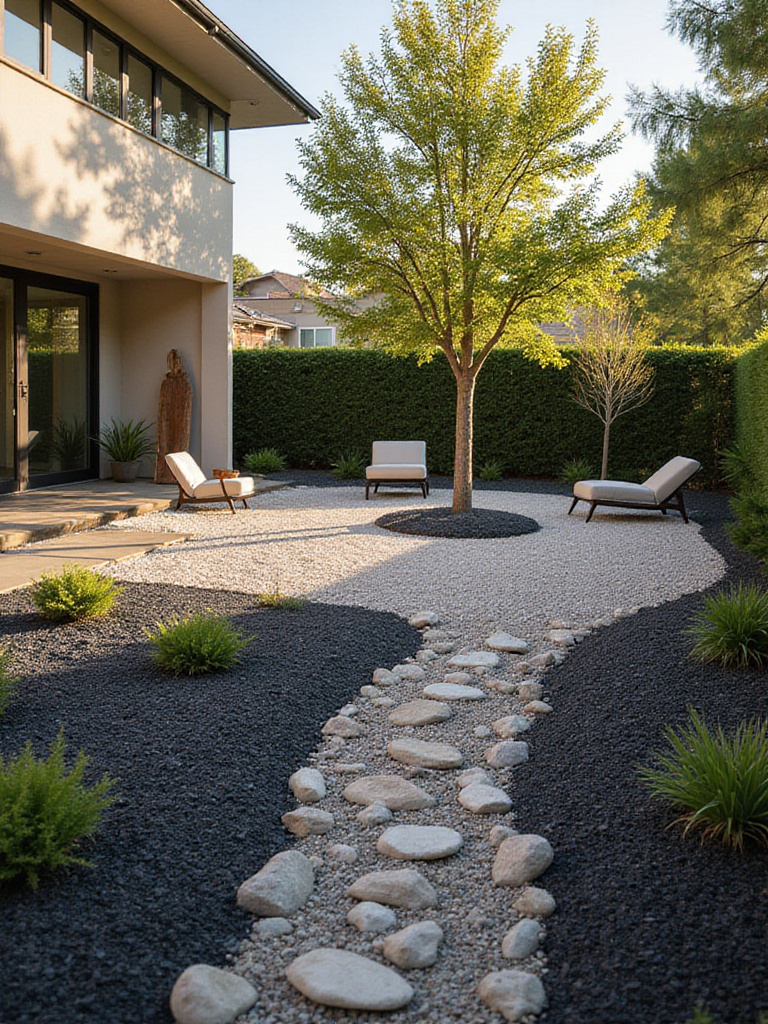
When incorporating stone, resist the urge to use many small pieces that create visual clutter. Instead, select fewer, larger stones with interesting shapes and textures, positioning them thoughtfully to create relationships between elements. For gravel areas, choose materials with consistent size and subdued coloration that won’t distract from plants and other features. The sound of gravel underfoot adds an auditory dimension that heightens awareness as you move through the space.
Unlike conventional options, this approach reduces maintenance while increasing mindfulness—creating spaces that remain beautiful throughout the seasons without demanding constant attention, allowing you to enjoy your yard rather than just maintain it.
16. Grow Up with a Vertical Garden Wall
Vertical gardens bring nature to eye level, creating intimate encounters with plants that might otherwise be overlooked. In small spaces particularly, growing upward makes mindful use of available surfaces, transforming blank walls and fences into living tapestries that change with the seasons and reward close observation.

When designing vertical gardens, consider viewing distance and scale. For walls seen primarily from a distance, use larger plants with bold textures arranged in simple patterns. For close-up viewing, incorporate smaller plants with interesting details that invite inspection. Include plants with different growth habits—trailing, mounding, upright—to create dynamic compositions. Remember that simpler arrangements often have more visual impact than complex designs.
The designer’s attention to detail shows in how vertical gardens can transform problematic spaces like narrow side yards or blank walls into contemplative features that draw the eye and create moments of connection with nature even in the most urban environments.
17. Style Your Space with Container Gardens
Container gardens offer unmatched flexibility in mindful yard design, allowing you to create mobile compositions that can be rearranged as needs change or moved to follow optimal light conditions. They’re particularly valuable in rental properties or spaces with poor soil, bringing nature to places where in-ground planting isn’t possible.

When selecting containers, choose quality over quantity. A few well-crafted vessels in complementary materials create more impact than many mismatched pots. Consider how containers will weather over time—natural materials like stone, ceramic, and wood develop patina that adds character, while plastic often degrades and looks dated. Group containers in odd numbers and varying heights to create dynamic compositions, and leave adequate negative space between groupings.
While designed for the living room, we’ve seen creative uses in outdoor spaces where containers define functional areas without permanent construction—creating flexible yard ideas that can evolve as your needs change.
18. Personalize Your Yard with Garden Art
Art in the landscape creates focal points for contemplation, but mindful garden art is integrated rather than imposed. The most successful pieces emerge naturally from their surroundings or create meaningful contrast that invites reflection. In Japanese gardens, art elements are often partially concealed, revealed gradually as one moves through the space—creating moments of discovery that reward attentive presence.

When selecting garden art, resist the temptation of mass-produced pieces that have no connection to your personal journey. Instead, choose or create items with personal significance—a stone collected from a meaningful place, a sculpture by a local artist, or a simple arrangement of found objects. Position art where it will be encountered naturally rather than demanding attention from across the yard. The best garden art changes with light and weather, offering different experiences throughout the day and seasons.
The composition comes together when you allow art elements to emerge organically from your design rather than imposing them—creating yard ideas that feel authentic and personally meaningful rather than decorated.
19. Define a Quiet Seating Corner
A dedicated space for stillness might be the most important element in a mindful yard. This isn’t about elaborate furniture or complicated design—often the simplest arrangements are most effective. A single bench beneath a tree, a pair of chairs facing a garden view, or a small platform for meditation can become the heart of your outdoor experience, providing a destination for daily moments of presence.

Position this quiet corner where it feels naturally protected and removed from household traffic patterns. Consider what you’ll experience while seated there—the play of light, seasonal changes in nearby plants, the sound of leaves or water. Face seating toward views worth contemplating, whether distant landscapes or the detailed beauty of a nearby garden bed. Include a small side table for a cup of tea or journal, encouraging longer stays and deeper connection.
As morning light filters through, the texture creates constantly changing patterns that reward extended observation—the essence of mindful yard design is creating spaces that reveal themselves slowly to those who take time to truly see.
Conclusion
Creating a mindful yard isn’t about following trends or achieving a particular look—it’s about designing spaces that support your well-being and deepen your connection to the natural world. By incorporating these 19 yard ideas with intention and simplicity, you can transform your outdoor space into a sanctuary that balances aesthetic beauty with functional needs.
Remember that the most successful yards evolve over time, developing in response to how you actually use and experience the space. Start with the elements that speak most strongly to your current needs, implement them with care and attention to detail, and allow your yard to mature naturally. The resulting space will be more than just beautiful—it will be a living extension of your home that supports a more balanced, present way of living in our increasingly digital world.


